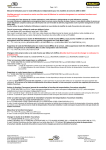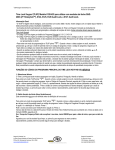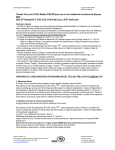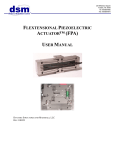Download VATS Interrogator/Reader
Transcript
VATS Interrogator/Reader TT4004 Thank you for purchasing a Lockmasters VATS Interrogator / Reader. Your Interrogator is a carefully engineered solid-state device designed to give you years of trouble-free service. Please read the following instructions carefully to familiarize yourself with the features of the Lockmasters Interrogator before using. Be sure to save these instructions for future reference. Important Safety Information As with any tool, safety precautions should be observed during handling and use. Before connecting this device to any vehicle, please consult the vehicle manufacturer’s service manual. Follow all vehicle safety precautions carefully. Many vehicles equipped with VATS/PASSkey are also equipped with an airbag. Follow all manufacturers’ safety precautions relevant to the airbag BEFORE using the Lockmasters’ Interrogator/Reader. High temperatures can damage the electronic components within this device. Do not store your Interrogator/Reader anywhere that temperatures may exceed 125 degrees F. Do not store in direct sunlight or near hot appliances such as radiators or stoves. Do not immerse in water or clean with harsh solvents. Do not attempt to disassemble your Lockmasters’ Interrogator/ Reader. Opening the case of your Lockmasters Interrogator/ Reader will void your warranty. There are no user serviceable components within. See warranty information for service procedures. Use only 9 volt alkaline batteries. Any battery may leak electrolyte with age; battery should be changed at least once a year. Do not dispose of batteries in fire or attempt to recharge alkaline batteries. When changing the battery, make sure that the selector switch is in the “INTERROGATE” position. Accidentally reversing the polarity of the battery while the unit is in the “READ” position will seriously damage the device. This is NOT covered by your warranty. Steering Column Wiring Test Lead Function Selector Switch Resistor Code Selector Dial Interrogation Lead Compartment for 9V battery is located on the underside of the Interrogator/ Reader. Always observe battery polarity when changing battery. Key Reader Slot OVERVIEW OF THE VATS / PASSKEY SYSTEM The original factory installed anti-theft system used on GM passenger cars beginning in 1986 is known as either VATS (Vehicle Anti-Theft System), or PASSkey (Personalized Automobile Security System). Both names refer to the same system. Throughout this manual, we will use the term VATS for simplicity. The heart of the VATS system is a resistor pellet imbedded in the shank of the ignition key. Each VATS key will have one of fifteen different resistor values. When the VATS key is inserted into the ignition switch, the resistor pellet is positioned between a pair of contacts located inside the ignition lock. As the lock is turned, the on-board computer routes an electric current through the resistor pellet and determines the value of the resistor. If the value of the resistor pellet in the key matches the value stored in the computer’s memory, the computer allows the car to start. If the value of the resistor pellet does not match the value stored in memory, the car will not start, and a timer will prevent the car from starting, even with the correct key, until a predetermined penalty period has elapsed. The Lockmasters’ Interrogator/Reader is designed to allow you to conveniently “feed” the onboard computer any one of the fifteen resistor values, and to determine the value of the resistor pellet in a key for duplication. The Lockmasters’ Interrogator will also allow you to check for a damaged resistor pellet, and perform tests for faults in the ignition lock contacts or wiring. For more information on the VATS system, see “VATS MADE SIMPLE” DVD that was included with your interrogator. Reading A Key The key reader can be used with or without the test probes connected to the Interrogator / Reader. IMPORTANT - if the test probes are connected to the Interrogator / Reader, the connectors at the ends of the test probes must NOT be connected to each other. This will prevent the Reader from reading the correct resistance value. TO READ THE VALUE OF THE RESISTOR PELLET IN A KEY: 1. Set the FUNCTION SELECTOR switch to “READ”. Then, the red LED labeled “KEY READER” will light. If the red LED does not light, or is dim, this indicates that the battery needs to be replaced. 2. Set the “RESISTOR CODE SELECTOR” knob to position one. 3. Insert the key to be read into the “KEY READER” slot, making sure that the key is inserted fully. (NOTE: the key reader slot will accept both single-sided and double-sided VATS keys.) 4. If the green LED labeled “KEY MATCH” lights, then the key has a resistor code of one. If the green LED does not light, rotate the “RESISTOR CODE SELECTOR” knob until the green LED lights. If the green “KEY MATCH” LED does not light, this indicates that the resistor pellet in the key has been damaged. 5. The resistor code number of the key is shown by the position of the “RESISTOR CODE SELECTOR” knob. To check that you have selected the proper key blank, insert the blank into the key reader slot without changing any of the settings on the Interrogator / Reader. If you have selected the correct blank, the green “KEY MATCH” LED should light immediately. TT4004INSTPDF Copyright © 2013 Lockmasters Inc. 1/2013 ...continued on next page 800.654.0637 • Fax 859.885.1731 [email protected] • www.lockmasters.com 2101 John C.Watts Dr., Nicholasville, KY 40356 VATS Interrogator/Reader TT4004 continued from previous page... Interrogating A Car Equipped With The Vats System Before you can interrogate any VATS system, you must first make a working mechanical key. This can be done by obtaining the key code number or by disassembling the steering column. (For more information on steering column disassembly, see Tech-Train video #553 “GM STEERING COLUMNS”, #556 “Airbag STEERING COLUMNS VOL. 1” or #568 “Airbag STEERING COLUMNS VOL. 2”.) Warning: if you are working on a car equipped with airbags, follow all factory diagnostic procedures for the airbag before interrogating the system. Failure to follow factory service procedures can result in an accidental deployment of the airbag and/or personal injury or death. 5. If the car does not start, turn the ignition switch off and set the RESISTOR CODE SELECTOR knob to the next value you wish to try and wait until the penalty period* has passed. 6. Attempt to start the car. If the car does not start, repeat steps 5 & 6, using all resistor values, until the car does start. *The “Penalty Period” varies from car to car. However, if the timer is working correctly, waiting three minutes between starting attempts is sufficient. Many people recommend waiting four minutes between starting attempts, just to be safe. Determining the exact penalty period of a particular vehicle requires a working key. Once you have a working mechanical key, you can use the Lockmasters Interrogator to interrogate the system in one of two ways. Vats System Tests METHOD #1 (Without the TT-4002 VATS Bypass Adapter) (To determine if VATS system is malfunctioning.) 1. Remove the screws securing the hush panel to the lower edge of the dashboard, and locate the VATS wire leading from the steering column into the wiring harness. 2. Disconnect the VATS connector and attach the matching leads from the Lockmasters Interrogator / Reader. 3. Set the FUNCTION SELECTOR switch on the Lockmasters Interrogator to “INTERROGATE” and set the RESISTOR CODE SELECTOR to the desired setting. (NOTE: Resistor value #1 is not used on vehicles built in 1989 or later and resistor value #1 was never used on vehicles equipped with double-sided VATS keys.) 4. Attempt to start the car. If the car starts, the resistor value stored in the computer’s memory is shown by the position of the RESISTOR CODE SELECTOR knob. 5. If the car does not start, turn the ignition switch off and set the RESISTOR CODE SELECTOR knob to the next value you wish to try and wait until the penalty period* has passed. 6. Attempt to start the car. If the car does not start, repeat steps 5 & 6, using all resistor values, until the car does start. Vats Fault Test 1.Determine correct key code. (See “READING A KEY”) 2.Connect “TEST PROBES” to matching connector of VATS wire located below dash. 3.Set “Function Selector” switch set to “INTERROGATE”. 4.Set “Resistor Code Selector Knob” to correct code and attempt to start the car. If car starts, fault is in steering column. If car does not start, fault is downstream of steering column; refer to vehicle service manual. Steering Column Test (To determine if contacts in lock or steering column wire are malfunctioning.) 1.Connect “STEERING COLUMN WIRING TEST LEAD” to matching connector of VATS wire located below dash. 2.Set “Function Selector” switch to “READ”. 3.Set “Resistor Code Selector Knob” to correct code for the vehicle and then insert the VATS key into the ignition and rotate through all positions. The green “KEY MATCH” LED should light. 4.If the green “KEY MATCH” LED does not light, or lights intermittently as the key is turned, replace the lock. METHOD #2 (With the TT-4002 VATS Bypass Adapter) 1. Insert a working mechanical key into Bypass Adapter. 2. Connect the test probe from the Lockmasters Interrogator / Reader to the Bypass Adapter. 3. Insert the mechanical key / Bypass Adapter combination into ignition lock. 4. Set the FUNCTION SELECTOR switch on the Lockmasters Interrogator to “INTERROGATE” and set the RESISTOR CODE SELECTOR to the desired setting. (NOTE: Resistor value #1 is not used on vehicles built in 1989 or later and resistor value #1 was never used on vehicles equipped with double-sided VATS keys.) 4. Attempt to start the car. If the car starts, the resistor value stored in the computer’s memory is shown by the position of the RESISTOR CODE SELECTOR knob. TT4004INST Copyright © 2013 Lockmasters Inc. 1/2013 800.654.0637 • Fax 859.885.1731 [email protected] • www.lockmasters.com 2101 John C.Watts Dr., Nicholasville, KY 40356













